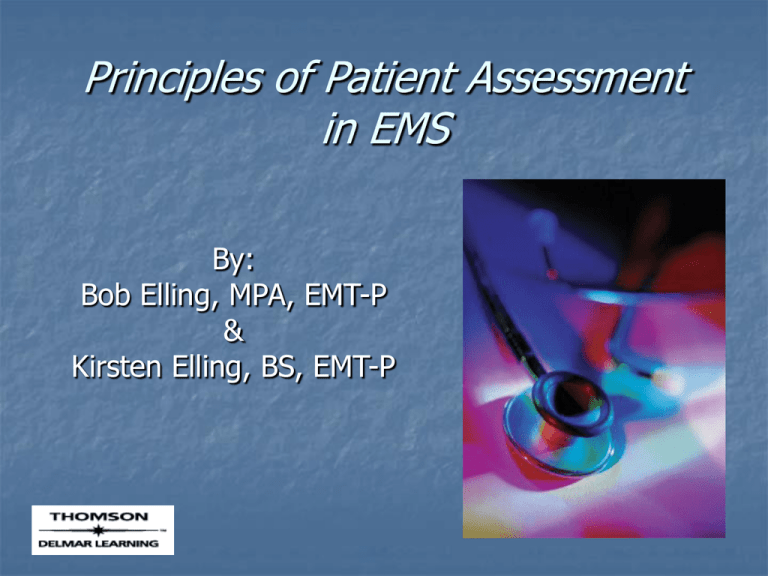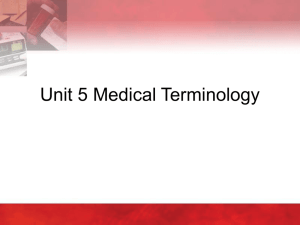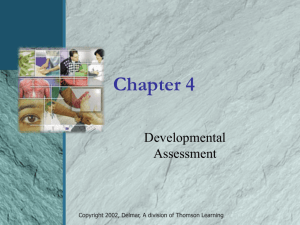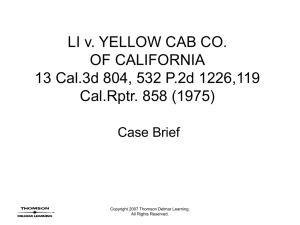Principles of Assessment for EMS by: Bob & Kirsten Elling
advertisement

Principles of Patient Assessment in EMS By: Bob Elling, MPA, EMT-P & Kirsten Elling, BS, EMT-P Chapter 9 – Focused History and Physical Exam of the Medical Patient © 2003 Delmar Learning, a Division of Thomson Learning, Inc. Objectives Describe the approach for obtaining a focused history from a responsive medical patient. Explain how the EMS provider might obtain a focused history from an unresponsive patient. Provide examples of positive findings and pertinent negatives for a medical patient. © 2003 Delmar Learning, a Division of Thomson Learning, Inc. Objectives (continued) Describe how the two acronyms OPQRST and SAMPLE are used to obtain essential medical history information. List the components of the focused physical exam (PE) for the medical patient. © 2003 Delmar Learning, a Division of Thomson Learning, Inc. Objectives (continued) Describe how the approach to the PE of a responsive medical patient differs from the approach to the unresponsive patient. © 2003 Delmar Learning, a Division of Thomson Learning, Inc. Introduction In the absence of trauma it is most likely a medical complaint Determine the chief complaint Responsive patients – begin SAMPLE & FH, get the history of present illness Positive findings Pertinent negatives © 2003 Delmar Learning, a Division of Thomson Learning, Inc. FH & PE Medical Patient Determine if the patient is responsive Reasonable response Can interview patient if they are responsive Establish rapport and obtain consent © 2003 Delmar Learning, a Division of Thomson Learning, Inc. The Responsive Medical Patient CC OPQRST SAMPLE Focus PE on specific body system: Respiratory or cardiac Neurological or behavioral Abdominal or obstetrical Geriatric or pediatric © 2003 Delmar Learning, a Division of Thomson Learning, Inc. Questions to Ask CC – Why was EMS called? O – When did symptoms/ CC begin? P – What seems to provoke it (ie: exercise, fever)? Q – How do you describe the sensation (ie: crushing, stabbing, pressure…)? R – Where is the pain & where does it go? Does anything relieve it? S – How would you rate this experience on a scale of 1 to 10? T – When did it start? © 2003 Delmar Learning, a Division of Thomson Learning, Inc. Responsive Medical Patient: SAMPLE Examples S – nausea, vomiting, blurred vision A – drugs, insects, plants, environmental M – lasix, potassium, insulin, penicillin P – recent surgery, CABG, pacemaker, diabetes L – meal, drinks, meds E – stress or emotional event © 2003 Delmar Learning, a Division of Thomson Learning, Inc. Responsive Medical Patient: Additional Steps Focused PE (guided by the CC): Respiratory Cardiac Neurological Behavioral Abdominal Geriatric Pediatric Multiple body systems evaluated as needed (skin, muscles, circulatory, GI…) © 2003 Delmar Learning, a Division of Thomson Learning, Inc. The Unresponsive Medical Patient Begin with the PE, then talk Perform a rapid physical exam (RPE) Get baseline VS Consider other tests: EtCO2 Pulse oximetry Temperature ECG Blood sugar © 2003 Delmar Learning, a Division of Thomson Learning, Inc. Speak to The Family & Bystanders Ask about SAMPLE history Ask about patient’s general health status Ask for list of meds Ask about advanced directives Take one family member along to the hospital © 2003 Delmar Learning, a Division of Thomson Learning, Inc. Look for Clues! Vial of Life Medic alert bracelet, necklace, or anklet Global Med-Net service Look in the refrigerator for meds Have the police look for a wallet card Look for meds and check them in your pocket reference © 2003 Delmar Learning, a Division of Thomson Learning, Inc. Conclusion The FH & PE follows one of two pathways depending if the patient is responsive or not responsive. The order of steps in the FH & PE of the medical patient depends on the patients responsiveness. The exam is either rapid, in the patient who is not responsive, or focused in the responsive patient. © 2003 Delmar Learning, a Division of Thomson Learning, Inc.






